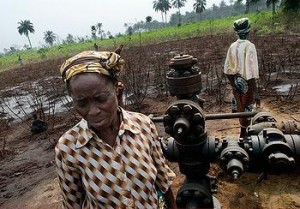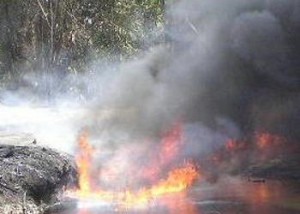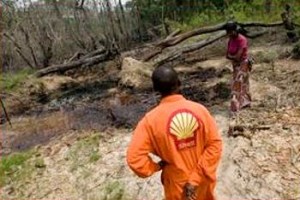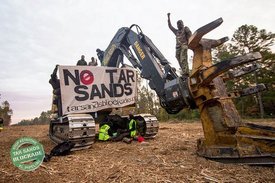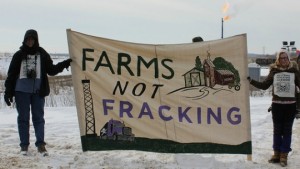http://www.petroleumnews.com/pntruncate/575533357.shtml
Environmental consultant questions feasibility of using oil dispersant chemicals in responding to an Arctic offshore oil spill
by Alan Bailey
Lauded by some as a major contributor to the cleanup of spilled oil following the 2010 Deepwater Horizon disaster in the Gulf of Mexico and slammed by others as environmentally dangerous, the use of chemicals to disperse oil slicks has become a controversial topic.
The concept behind dispersant use is simple. The dispersant chemicals, acting a bit like dishwashing liquid, break the oil into tiny particles, greatly increasing the surface area of oil exposed to water and hence greatly accelerating the rate at which oil-consuming microbes devour the oil, causing the oil to disappear.
But do dispersants, demonstrated in laboratory conditions, work in the hurly-burly of a real spill response situation? And, more particularly, would dispersants work, were there to be an oil spill catastrophe in the Arctic offshore?
Skeptical
Jeffrey Short, an environmental consultant working for Oceana, a marine conservation organization, is very skeptical about the potential effectiveness of dispersants in the Arctic. Short, who worked as a research chemist for the National Oceanic and Atmospheric Administration for 31 years and has published more than 60 scientific papers on Arctic pollution, spoke at the Alaska Forum on the Environment on Feb. 4, giving his views regarding the problems associated with dispersant use in the Arctic.
Short, who said he had been involved in the Deepwater Horizon response, working for private entities, said that claims about the effectiveness of dispersants during that response had been overstated, and that there was a lack of evidence for dispersant chemicals having had any impact in boosting the natural biodegradation of oil that had spewed from the out-of-control, seafloor well. For example, no one observed the milky appearance of dispersed oil in the water, he said.
And, although the government-published oil budget calculator for the Deepwater Horizon response indicated that dispersants had been somewhat effective, the technical underpinnings of that conclusion, as expressed in the budget calculator report, appear far short of convincing, he said.
Goldilocks circumstances
The effective use of dispersants requires a “Goldilocks” set of circumstances, in which the wind is strong enough to cause the necessary wave action for mixing oil with dispersant chemicals, but not so strong as to blow away the fine spray of dispersant, normally applied from an aircraft, Short said. And seas that are too rough can cause dispersants to escape into underlying water, rather than mix with an oil slick on the surface, he said.
Also, there is typically a relatively short time window following an oil spill, during which dispersants can be used, as evaporation and emulsification of the oil eventually renders the oil unresponsive to dispersant chemicals.
Given seasonal ice, the frequency of strong winds and the prevalence of sea fog in the Arctic Ocean, the appropriate conditions for the application of dispersants in Arctic seas may only occur for 10 percent of the time, Short said.
Lab tests
Short said that 10 years ago he had conducted some laboratory tests for the Prince William Sound Regional Citizens’ Advisory Council, testing the effect of a commonly used oil dispersant on Alaska North Slope crude oil in sub-Arctic conditions. Those tests demonstrated that the dispersant did not work well in cold water, with dispersant effectiveness dropping with reduced water temperatures and with low water salinity, Short said. These results do not bode well for dispersant effectiveness in the Arctic – in addition to the effect of low water temperatures on dispersant action, melting ice in the Arctic seas tends to create a layer of low salinity water near the sea surface, he said.
Compounding the technical issues relating to the potential effectiveness of dispersants in the Arctic is the sparse transportation architecture for the resupply of dispersant chemicals to field responders, Short said.
Asked about the possibility that low water temperatures would slow oil degradation, thus extending the time window within which dispersants would be effective, Short responded that the weathering of oil is less sensitive to temperature than to wind, of which there is plenty in the Arctic. The rate of incorporation of water into the oil, a phenomenon that takes place quite quickly, depends on the composition of the oil, he said.
Continuing debate
Short’s comments come amid a continuing debate over the realistic feasibility of conducting an offshore oil spill response in the Arctic. And a report, issued in November by the U.S. Arctic Research Commission and the U.S. Army Corps of Engineers, after overviewing the considerable body of research already done into oil spill response in the Arctic offshore made a number of recommendations for further research, including a recommendation that people evaluate the effectiveness of dispersants in Arctic conditions.
A joint industry program, known as SINTEF and based in Norway, conducted a series of large-scale field experiments in the mid-2000s, testing the use of various response techniques, including dispersants, using oil deliberately spilled in the sea under carefully controlled conditions at an Arctic location. SINTEF reported that it had found rates of oil weathering in broken ice conditions to be considerably lower than rates observed for the same oil in open water. The final report for the program also said that researchers had experienced success in dispersing oil in water around ice floes, by applying the dispersants from spray arms deployed from vessels and using the prop wash or jet motors of response boats to mix the dispersant with the oil.
Oil budget
A read of the technical documentation for the Deepwater Horizon oil budget calculator makes it clear that there was a wide range of expert opinion and no general agreement on the effectiveness of dispersants in the response to that disaster. A December 2012 paper in the Proceedings of the National Academy of Science presents an overview of the scientific findings from Deepwater Horizon. Written by senior officials from several federal agencies, including the U.S. Geological Survey and the National Oceanic and Atmospheric Administration, the paper says that monitoring of oil in the water through a variety of techniques had provided oil particle size data consistent with expectations from chemical oil dispersion. The oil budget calculator subsequently concluded that chemical dispersion accounted for about 16 percent of the oil that had escaped from the well, the paper says.
Special thanks to Richard Charter
